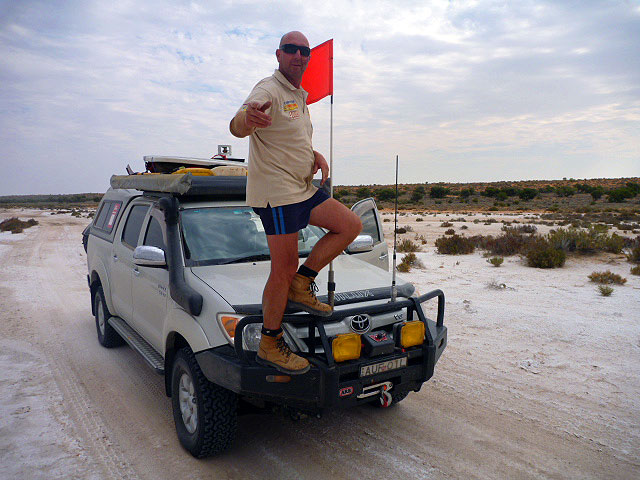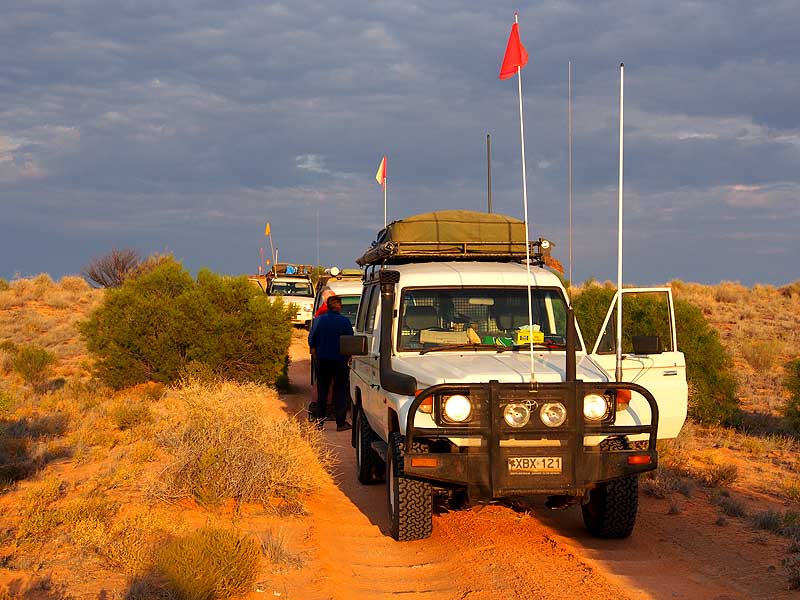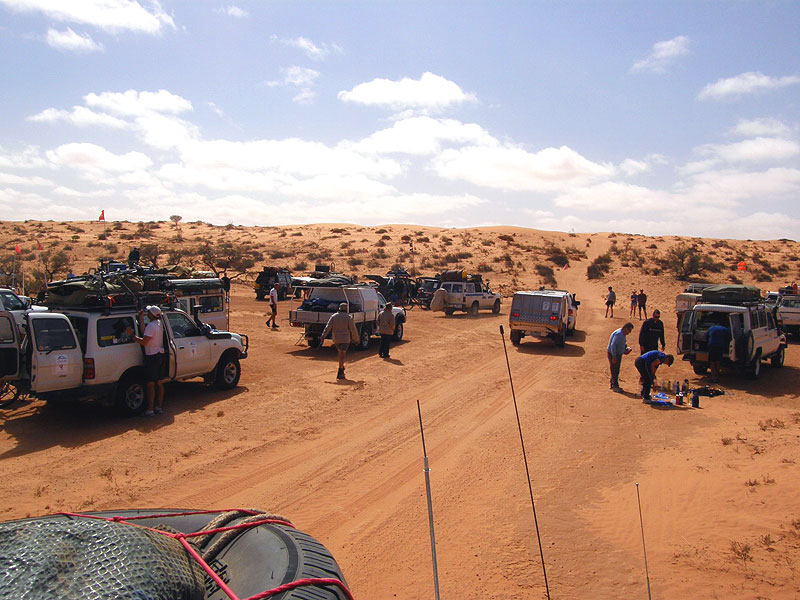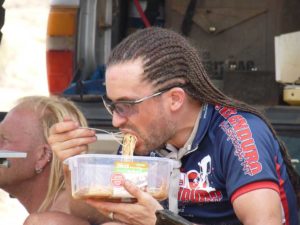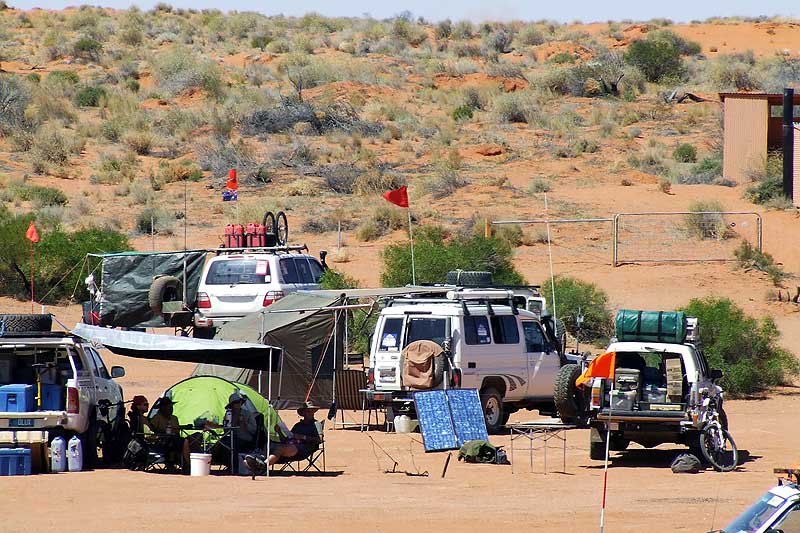Riders are required to have a dedicated support crew. Organising a top notch Support Crew, vehicle and equipment is vital.
If you don’t have access to a 4wd or a capable crew, we may be able to help by putting you in touch with our network of private crews.
Alternatively, we recommend the following commercial tour operators:
Life Cycle Adventures
Alice Spring Expeditions
Private support crews are usually from 4wd clubs or have supported riders previously and are keen to return. If you need help with getting a support crew, please contact us using our contact page: http://desertchallenge.org/contact/
If you are a first time competitor, we can put you in touch with experienced riders who will be happy to advise you on how to prepare.
It is up to you to discuss and clarify your expectations with your crew. It is very difficult to provide support for a rider if you do not know exactly what is expected of you.
Typical Support Crew Responsibilities
Set up shade at the lunch break and the full overnight camp each day.
Prepare all meals for rider(s) and crew.
Prepare and deliver water bidons to Water Stop vehicle at designated times (lunch and evening locations).
Prepare a bag with fresh riding gear, comfortable clothing and footwear for the lunch break, towel/facewasher/toiletries, sunhat and flynet for rider(s) use when they arrive at the end of each stage.
Attend to rider(s) and crew laundry as required.
Check that rider(s) have everything they need prior to your departure each morning and afternoon. This might include a spare water bottle, hydration pack stocked with water, snacks, spare tubes, tools, sunscreen, and a warm jacket for cold morning starts.
Provide a comfortable bed for lunch breaks. A swag, stretcher or sun lounger with adjustable back are recommended.
A massage is always welcomed.
If you have sufficient water, setting up an area for a wash is appreciated.
Check the bike(s) prior to each stage. Make any adjustments in consultation with rider(s). You may need to oil the chain, change tyres or adjust components as directed.
All crews and officials are encouraged to be on the finish line to cheer each rider home. You will need to carry your rider’s bike back to your campsite. A shower of water from a handheld spray bottle is useful to cool riders down quickly.
Be aware of riders health and comfort at all times and consult medical officers when necessary.
Be responsible for the vehicle, ensure that equipment is safely and securely packed and monitor tyre pressure and fuel usage over the race.
Note: Riders are participating in an extreme endurance event. Regardless of athletic ability or experience every rider is at risk of exhaustion and dehydration. Support crew must be able to carry out all tasks without assistance from riders.
Support Crew Routine
Pack own sleeping gear and get some water on the boil for the much needed 5am brew.
Ensure rider is up, and give them breakfast (ideally, prep the evening before).
Pack up rider’s tent and sleeping gear, and any camp gear left out.
Take rider and bike to a crew travelling in the rear convoy so they can rest until their 6am start time.
Join front convoy for a 5:30am departure.
Arrive at lunch stop around three hours later depending on terrain and track conditions.
Set up lunch stop first, once the riders arrive it gets busy. This will include erecting a tarp for shade, putting out chairs and bed, preparing food, washing any breakfast dishes, doing any laundry and continually fine tuning your packing system. Don’t forget to eat and refill your own water bottles as necessary.
As Water Stop vehicles arrive, collect your rider’s bidons, rinse, refill and return them. A second set of bottles will help as you can have them pre filled and ready to drop off when you collect the empties.
Support crews travelling in the rear convoy see the riders off at 6am. They then have an hour to eat, pack up, and depart. They MUST leave with the sweep vehicle which will depart roughly an hour behind the riders.
Support crews in the rear convoy are available to pick up and transport their rider(s) should they be ‘swept’ during the stage. The sweep vehicle also has some capacity to carry bikes and riders.
The afternoon routine is similiar. Support crews travel in either the front convoy departing at 1:30pm, or the rear convoy travelling behind the sweep vehicle. Crews travelling in the front convoy need to keep a close eye on the time so that they are packed and get their rider and bike moved to a support crew travelling behind before they depart. The race restarts at 2pm.
Night camps are very social. Firstly camp is set up and tasks attended to. At 7:30pm there is a nightly briefing to catch up on results and events of the day as well as any announcements for the following day. It is recommended that you pack away as much as possible in the evening to prepare for a fast getaway in the morning.
For an amusing and informative description of the daily routine read Gaye Bourke’s A Day in the Life
Food and Water
It is important that riders receive adequate fluid and nutrition. The arid environment (average humidity of <20%) is extremely dehydrating for both riders and crew. Allow at least 20 litres per day per rider and 10 litres per day per crew member for drinking water. The need for constant hydration cannot be stressed enough – it is not only riders that collapse and require medical intervention … sometimes support crew forget to look after themselves and become severely dehydrated.
Remember that you will need additional water for cooking, washing and laundry.
Discuss nutritional requirements before you go. Lots of different options seems to work best. It is very much a matter of individual taste and a topic of endless discussion before, during and after the race.
The riders need to carry some snacks with them to eat during the stage. This can be fruit bars, energy bars, drink supplements or whatever suits. Many sugary powerbars and gels do not stand up to the extreme heat well.
It is recommended that riders consume at least 50 gm of carbohydrate within ten minutes of finishing each stage to optimise their recovery. A can of cold Coke is a popular choice, as is a sports drink. They should try to consume a reasonable amount of food in the first 30 minutes.
Equipment
Keep it simple. During the course of the race you will be setting up and breaking camp ten times. The choice of camping equipment is endless and widely debated.
Pop-up Tents are much admired for their ease of use. Swags are even easier. Whatever you choose make sure you are well and truly familiar with it before you leave home. Extremely strong winds are common so make sure that you have adequate ropes and pegs.
Shade is essential. Thin flimsy plastic tarps are likely to get ripped apart in the first decent gust of wind. Majority of the support vehicles have a roll-out awning which makes it simple to setup and pack away.
Careful packing of gear is important as the vehicle will bounce around going over the dunes. Everything must be held down.

